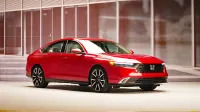2023 Honda Accord First Look: Not ‘all’ new, but it probably doesn’t matter

In the pantheon of automotive legends, the Honda Accord has a pedestal right up at the front. Whether measured by sales volume, customer loyalty or overall excellence, it’s been a tough one to beat since it first washed up on North American shores. Now it’s time to see if the 11th-generation, 2023 Honda Accord can keep the streak going.
To call it all-new would not be accurate. The length and track might be different by about a half inch, but the wheelbase, height and width are all the same. So is the colossal 16.7-cubic-foot trunk, and the interior sure seems identically enormous despite the official dimensions not being available at this time. Anecdotally, the silhouette is incredibly similar to the outgoing Accord, with the updated styling amounting to something north of your typical mid-cycle refresh but less than the usual “all-new” from-scratch redesign. It generally looks lower, longer and pointier.
This approach is not dissimilar from what we’ve seen elsewhere in the industry in recent years as car companies divert dollars away from increasingly less popular cars and toward electric R&D. If that’s the case here, then at first look at least, it’s hard to say that the 2023 Honda Accord is worse for it. The previous generation remained so excellent and competitive throughout its life that it was actually surprising to find out that it was due for a replacement (Accords have traditionally lasted five or six years).


OK, so besides the styling, what has been changed? The main element is the model structure and what’s under the hood. The LX and EX trims are now exclusively paired with the 1.5-liter turbocharged inline-four that’s been worked over to be more refined and responsive despite the carry-over 192-horsepower output. Its CVT now simulates gear changes under heavy throttle.
The Accord hybrid is no longer a separate model, and instead it’s the only powertrain fitted to the Sport, EX-L, Sport-L and Touring trim levels. It’s the same all-new hybrid powertrain that so impressed in the 2023 Honda CR-V, complete with more power (204 horsepower and 247 pound-feet of torque) and simulated gear shifts that dramatically improve drivability relative its predecessors and Toyota’s droning hybrids. Meanwhile, the 2.0-liter turbo-four has been discontinued and don’t bother asking about the manual transmission.
Despite the carry-over platform, the new Accord’s chassis is more rigid thanks to stiffer body supports and front brace bars that apparently improve the ride, handling and overall refinement (note that all of these were very good on the Accord before). The suspension was retuned for a more engaging driving experience, specifically for the purposes of reducing steering friction and increasing steering smoothness (similar efforts were made with success in the CR-V).
Related: Junkyard Gem: 1980 Honda Accord Sedan

Although the interior space remains similar if totally the same, the look has been upgraded by adopting the same sporty motif as the Honda Civic, HR-V and CR-V. The metal-look air vent trim consists of a more triangle-filled lattice that looks a bit more robust and in keeping with a pricier car like the Accord. Materials quality throughout is a step above its aforementioned siblings, though to be accurate, we only got a chance to check out the range-topping Accord Touring trim level.
The Accord also differs from its siblings by offering a new 12.3-inch touchscreen as standard equipment on the hybrid trim levels (the same 7-inch touchscreen found on those siblings is found in the LX and EX). Its widescreen layout allows for split-screen functionality, and rather than menu buttons being docked on the bottom as in Honda’s 7- and 9-inch touchscreens, they are located on the left. They remain docked when using Apple CarPlay and Android Auto, too, which is always appreciated.
You probably won’t need Android Auto in the Accord Touring, however, as it is the first Honda to get Google built-in capability that integrates Google Maps, Google Assistant and the Google Play app menu into the car. Maps in particular seems to be a functional upgrade over what you’d get with the Apple CarPlay version, as the controls are a bit more advanced and indicative of an in-car navi. You don’t need a Google subscription or devices to use it, and Apple CarPlay is still available. We look forward to trying out this new 12.3-inch system, though it’s a shame it’s only available on the Touring. We’re guessing buyers of the new 2023 Honda Pilot will feel a bit short-changed, too.
.embed-container { position: relative; padding-bottom: 56.25%; height: 0; overflow: hidden; max-width: 100%; } .embed-container iframe, .embed-container object, .embed-container embed { position: absolute; top: 0; left: 0; width: 100%; height: 100%; }
Other notable tech enhancements include standard over-the-air updates and sharp-looking all-digital instruments, and a new Bose Centerpoint sound system on the Touring. The HondaSensing suite of driver assistance and safety technologies was also upgraded with better cameras and radar, and more natural responses from the adaptive cruise control and lane-keeping assist systems. We’re guessing the improvement leap won’t be as great here with the new Accord as it was with the Civic, CR-V and (likely) new Pilot as the outgoing Accord was already running more up-to-date systems.
Also on the safety front, the Accord now comes standard with front knee airbags and rear passenger side airbags, plus next-generation front airbags designed to reduce brain and neck injuries.
The 11th-generation Accord will once again be built in Marysville, Ohio, just as Accords have been for 40 years now. Specifically, 12.5 million of them. Even if folks aren’t as interested in sedans any more and this latest Accord isn’t as new as it might’ve been with past generation change overs, we’re guess that number will continue to rise at a healthy clip.
Related video:
.embed-container { position: relative; padding-bottom: 56.25%; height: 0; overflow: hidden; max-width: 100%; } .embed-container iframe, .embed-container object, .embed-container embed { position: absolute; top: 0; left: 0; width: 100%; height: 100%; }




